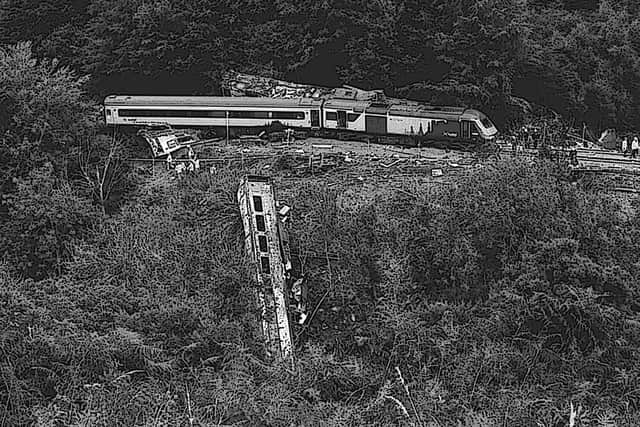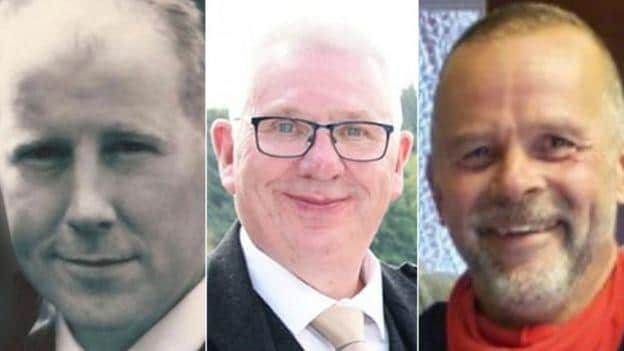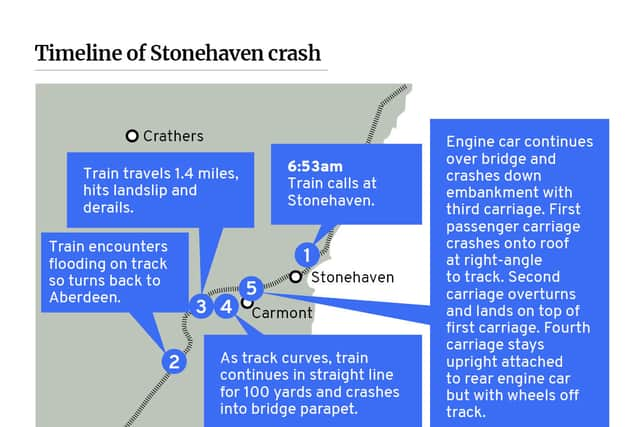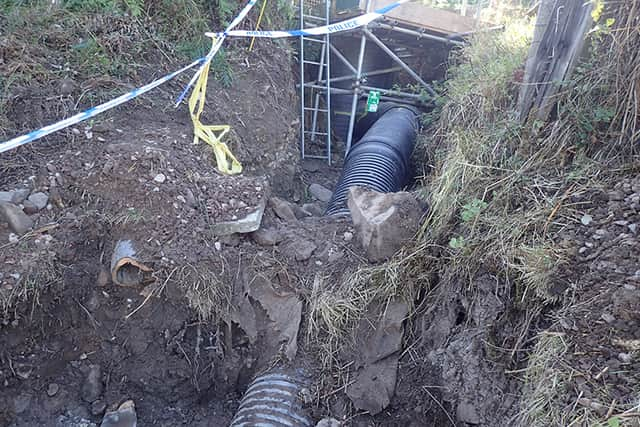Stonehaven train crash: what happened in rail accident, how many people died, and what caused it?
This article contains affiliate links. We may earn a small commission on items purchased through this article, but that does not affect our editorial judgement.
and live on Freeview channel 276
The “damning” findings that failings by Network Rail and collapsed outsourcing giant Carillion caused a fatal rail crash should be a “watershed moment” for safety, it was said.
Driver, Brett McCullough, 45; the conductor, Donald Dinnie, 58; and a passenger, Christopher Stuchbury, 62, were killed when a ScotRail train derailed at Carmont, near Stonehaven, Aberdeenshire, after hitting gravel and other stony material washed out from the drain.
Advertisement
Hide AdAdvertisement
Hide AdErrors in the construction of a drainage system by the construction firm meant it was unable to cope with heavy rain which fell in Aberdeenshire on the morning of the crash at 9.37am on 12 August, 2020, the Rail Accident Investigation Branch (RAIB) said.


The tragedy, which shocked the country, was the first involving the fatality of a passenger onboard a train in Britain since the Grayrigg derailment of 2007.
What happened in the crash?
The 6.38am service from Aberdeen to Glasgow was returning towards Aberdeen at the time of the accident due to the railway being blocked.
It was travelling at 73mph, which was just below the normal permitted speed for that line.
Advertisement
Hide AdAdvertisement
Hide AdThe RAIB said no instruction was given by railway controllers or signallers that the train should run slower, with one signaller telling the driver the line was “fine”.
Between 6am and 9am on the morning of the accident there was near-continuous heavy rain.
The 51.5mm which fell at the crash site was close to the average monthly total for the month of August in that region.
The train, which had nine people on board, had left Aberdeen at 6.38am bound for Glasgow and called at Stonehaven at 6.53am heading south.
Advertisement
Hide AdAdvertisement
Hide AdAt around 7am just after passing the Carmont signal box the train stopped after information was passed on about a landslip blocking the line ahead.
It was decided the train should return to Stonehaven, which required it to pass from the southbound line to the northbound one at crossing points near the Carmont signal box.
In order for the train to do this it was held at Carmont for more than two hours as work was done to secure the crossing points.
It was 9.28am before the signaller was able to authorise the train to proceed towards Stonehaven.
Advertisement
Hide AdAdvertisement
Hide AdMinutes later it crossed to the northbound line at the Carmont crossover, near the site of the former Carmont Railway Station, just over 5 miles west of Stonehaven.
However, about 1.4 miles after the crossover it encountered another landslip and derailed. After derailing, the train deviated to the left, before striking a bridge parapet which caused the vehicles to scatter, with the lead power car and one of its four carriages falling down an embankment.


What has the investigation said about the causes?
On the day of the crash, this caused a large amount of water to be diverted into the drain at one location, increasing the likelihood of gravel being washed out.
The RAIB concluded that if the system had been built in accordance with designs, it was “highly likely to have safely accommodated the flow of surface water”.
Advertisement
Hide AdAdvertisement
Hide AdThe drainage system was built during 2011 and 2012 to address a problem with ground stability.
RAIB deputy chief inspector, Andrew Hall, told the PA news agency: “The sad irony of the accident is that a fairly modern drain that was put there to reduce the risk of a landslip on a cutting slope was in fact the thing that brought the risk to the railway.”
The most significant difference between the design of the drainage system and its construction was the addition of a bund – a structure to protect against leaks – which significantly altered the flow of water.
Carillion, which went into compulsory liquidation in January 2018, failed to inform Network Rail it was adding the bund.
Advertisement
Hide AdAdvertisement
Hide AdInvestigators found no evidence that Network Rail carried out any inspection of the upper parts of the system between when it viewed the completed work in March 2013 and the accident.
They stated that the Government-owned company failed to add that section of the structure to an internal programme which would have triggered routine inspections and maintenance.
The inquiry also noted that the owner of the land where the system was installed took a photograph showing “slight erosion” in December 2012 which he passed on to Carillion or Network Rail.
This was “clear evidence of a problem requiring action”, the report stated.
Advertisement
Hide AdAdvertisement
Hide AdThe inquiry found the controllers had not been given the information or training they needed to effectively manage “complex situations” such as the one they were encountering on the day of the crash.
Network Rail’s management processes had not identified or addressed weaknesses in the way it mitigated the consequences of extreme rainfall.
The organisation also failed to implement measures following previous severe weather events.
Mr Hall said Network Rail “hadn’t moved far enough to eliminate” the risk of heavy rainfall.
Advertisement
Hide AdAdvertisement
Hide AdThe RAIB found that the refurbished HST train involved in the crash was designed before modern safety standards came into force.
It concluded “it is more likely than not that the outcome would have been better” if a train built to current regulations was involved.
Some 20 safety recommendations were made to improve railway safety, many of which were directed at Network Rail.


What has been the reaction to the findings?
Neil Davidson, partner at law firm Digby Brown Solicitors, which represents injured passengers and the relatives of one of the people killed, said the report highlights “a catalogue of failures within Network Rail”.
Advertisement
Hide AdAdvertisement
Hide AdHe said: “This is a damning report which highlights a catalogue of failures within Network Rail.
“The RAIB investigation clearly shows rail management had prior knowledge of several known risks – they were told to improve, yet still failed to act.
“This is the very definition of negligence and as a result people were killed or injured.
“It should come as no surprise that many now hope further action will be taken against Network Rail.
Advertisement
Hide AdAdvertisement
Hide Ad“Right now, as a bare minimum, those responsible for running and managing the railway need to swiftly provide survivors and families with the support they deserve while implementing all of the RAIB’s recommendations in full and without delay.”
Aslef general secretary Mick Whelan said: “This report is damning and makes for difficult reading, not least for the families of those who died and were injured.
“The failures identified in this report are so bad that we believe this must be a watershed moment in the way we ensure the safety of passengers and staff on our railway network.”


Kevin Lindsay, Aslef’s full-time organiser in Scotland, said Network Rail and ScotRail “must be held to account” as they “failed the staff and the passengers who were on the train”.
Advertisement
Hide AdAdvertisement
Hide AdHe also called for Alex Hynes, managing director of Scotland’s Railway, a group of Government and rail industry organisations, to resign.
“Given his involvement in both Network Rail and Abellio ScotRail, his position is untenable,” Mr Lindsay said.
Transport Secretary Grant Shapps said it would be a “disservice” to the men who died if lessons were not learned.
He said: “I fully expect the rail industry to ensure all the recommendations of this report are actioned and that the vital work to make our network safer and more resilient continues, so no other families have to experience what theirs tragically did.”
Advertisement
Hide AdAdvertisement
Hide AdScotRail chief operating officer Ian McConnell said: “This report makes for very sober reading.
“The RAIB is clear that the derailment was caused by debris washed out from a drain and onto the track, with failures in the specific drainage system installed by Network Rail in 2011/12 being a key factor.
“The majority of the RAIB recommendations relate to other parties but ScotRail will play its part fully in ensuring that safety lessons are learned.
“We are working closely with Network Rail and the wider industry to do everything possible to reduce the risk of something like this ever happening again.”
Advertisement
Hide AdAdvertisement
Hide AdWhat has Network Rail said?
Andrew Haines, Network Rail chief executive, said: “This report makes clear that there are fundamental lessons to be learnt by Network Rail and the wider industry.
“As well as expressing our deep sorrow and regret at the loss of the lives of Christopher Stuchbury, Donald Dinnie and Brett McCullough, it’s important that we acknowledge it should not have taken this tragic accident to highlight those lessons.
“We must do better and we are utterly committed to that.
“In the 18 months since the accident, we have inspected similar locations and drainage systems across the length and breadth of the country, and the added insight the RAIB has provided today will help us in our efforts.
“We also commissioned two independent taskforces led by world-class experts to help us better understand extreme rainfall events and how to better manage our cuttings, embankments and their drainage systems.
Advertisement
Hide AdAdvertisement
Hide Ad“We have invested tens of millions of pounds towards improving the general resilience of our railway and how we predict and respond to such events. But this remains a multi-generational challenge and there is still much to do.”
What other action is to be taken?
A steering group will examine the safety of older trains on Scotland’s railways.
The Scottish Government’s Transport Secretary, Jenny Gilruth, updated MSPs on the response to the RAIB report on Thursday afternoon.
She said: “Transport Scotland will convene a steering group to take forward implementation of the recommendations about the safety performance in accidents of older rolling stock, including HST (High Speed Train) rolling stock on ScotRail.”
Advertisement
Hide AdAdvertisement
Hide AdShe also said she was seeking an urgent meeting with her UK Government counterpart, Grant Shapps, to discuss the report.
The report highlighted that “lifeguards” – metal brackets in front of the lead wheels of a train – were less robust than on modern trains.
It recommended investigating the feasibility of strengthening the lifeguards on HST power cars.
Ms Gilruth said the train involved in the Stonehaven crash met the legal requirements for operation.
A message from the editor:
Advertisement
Hide AdAdvertisement
Hide AdThank you for reading. NationalWorld is a new national news brand, produced by a team of journalists, editors, video producers and designers who live and work across the UK. Find out more about who’s who in the team, and our editorial values. We want to start a community among our readers, so please follow us on Facebook, Twitter and Instagram, and keep the conversation going. You can also sign up to our email newsletters and get a curated selection of our best reads to your inbox every day.
Comment Guidelines
National World encourages reader discussion on our stories. User feedback, insights and back-and-forth exchanges add a rich layer of context to reporting. Please review our Community Guidelines before commenting.
